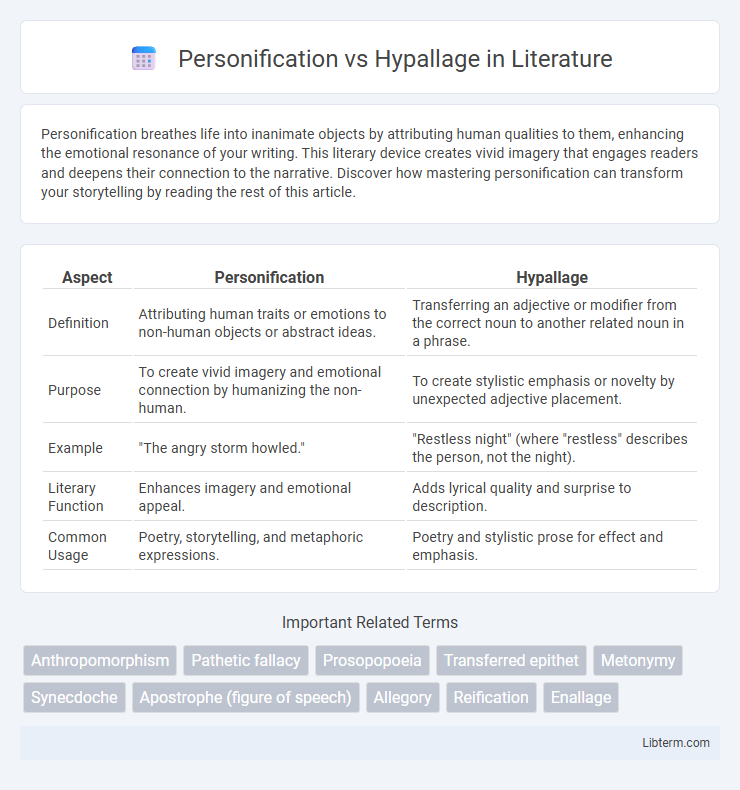Personification breathes life into inanimate objects by attributing human qualities to them, enhancing the emotional resonance of your writing. This literary device creates vivid imagery that engages readers and deepens their connection to the narrative. Discover how mastering personification can transform your storytelling by reading the rest of this article.
Table of Comparison
| Aspect | Personification | Hypallage |
|---|---|---|
| Definition | Attributing human traits or emotions to non-human objects or abstract ideas. | Transferring an adjective or modifier from the correct noun to another related noun in a phrase. |
| Purpose | To create vivid imagery and emotional connection by humanizing the non-human. | To create stylistic emphasis or novelty by unexpected adjective placement. |
| Example | "The angry storm howled." | "Restless night" (where "restless" describes the person, not the night). |
| Literary Function | Enhances imagery and emotional appeal. | Adds lyrical quality and surprise to description. |
| Common Usage | Poetry, storytelling, and metaphoric expressions. | Poetry and stylistic prose for effect and emphasis. |
Understanding Personification
Personification attributes human qualities to animals, objects, or ideas, enhancing vivid imagery and emotional connection in literature. It differs from hypallage, which involves the transference of an adjective or epithet from the appropriate noun to another, creating a subtle shift in meaning. Understanding personification is crucial for grasping how writers breathe life into inanimate elements, making abstract concepts more relatable and engaging.
Defining Hypallage
Hypallage is a figure of speech involving the transference of an adjective or epithet from the noun it logically qualifies to another noun within the same sentence, creating a striking or ironic effect. Unlike personification, which attributes human qualities to inanimate objects or abstract ideas, hypallage subtly shifts descriptive words to generate vivid imagery or emphasize particular aspects. This syntactic inversion enhances poetic expression by challenging conventional associations between words and their referents.
Key Differences Between Personification and Hypallage
Personification attributes human characteristics to non-human entities, enhancing imagery by making objects or ideas appear sentient or alive, whereas hypallage involves a syntactic shift where an adjective or modifier is transferred from its logical noun to another, creating a stylistic dissonance. In personification, the non-human subject explicitly gains human traits, while in hypallage, the modifier's reallocation leads to a poetic or paradoxical effect without necessarily anthropomorphizing. The key difference lies in personification's direct human attribution versus hypallage's structural adjective reassignment, impacting interpretation and literary tone.
Historical Origins of Both Devices
Personification traces its roots back to ancient Greek rhetoric and literature, where attributing human traits to non-human elements served to create vivid imagery and emotional connection in storytelling and poetry. Hypallage, a lesser-known figure of speech, dates back to classical Latin literature, notably used by poets like Virgil to create subtle shifts in syntax that enhance poetic effect by transferring adjectives between related nouns. Both devices evolved through centuries of literary tradition, influencing various genres and enriching expressive capabilities in Western literature.
Common Uses of Personification in Literature
Personification frequently appears in literature to attribute human traits to animals, objects, or abstract ideas, enhancing emotional connection and vivid imagery. This literary device enriches narratives by making non-human elements relatable and alive, often seen in poetry and children's stories. Unlike hypallage, which involves transferring an adjective from its appropriate noun to another for stylistic effect, personification directly endows inanimate things with human qualities.
Notable Examples of Hypallage
Hypallage, a rhetorical device where the natural relationship between two words is reversed, appears famously in Shakespeare's "Julius Caesar" with the phrase "happy with this contract," where happiness is attributed to the contract instead of the person. Another notable example is found in John Keats' "Ode to a Nightingale," where he writes "the forest's ancient trees," subtly shifting the adjective 'ancient' from the natural subject 'trees' to the forest itself. Unlike personification, which attributes human characteristics to non-human entities, hypallage creates a striking effect by transferring descriptors, thereby enriching poetic imagery and deepening interpretive layers.
Effects on Reader Perception
Personification attributes human qualities to non-human entities, creating vivid imagery that fosters emotional connection and empathy in readers, enhancing narrative engagement. Hypallage shifts traditional adjective-noun relationships, producing unexpected, thought-provoking expressions that challenge readers' perceptions and evoke imaginative responses. Both devices deepen interpretative layers, but personification generally evokes warmth and relatability, while hypallage stimulates cognitive intrigue and stylistic appreciation.
Personification and Hypallage in Poetry
Personification in poetry attributes human qualities to animals, objects, or abstract ideas, enhancing emotional engagement and vivid imagery. Hypallage, a subtler stylistic device, transfers adjectives or modifiers from their logical nouns to others, creating unexpected and thought-provoking descriptions. Both techniques enrich poetic expression by deepening meaning and evoking sensory or emotional resonance.
Pitfalls and Misinterpretations
Personification often risks oversimplifying abstract concepts by attributing human traits too literally, leading to cliches and weakened imagery. Hypallage, by shifting modifiers between nouns, can confuse readers if the relationship between words becomes unclear or illogical, resulting in misinterpretation. Both devices demand careful contextual balance to avoid ambiguity and preserve intended meaning in literary analysis.
Tips for Writers: Choosing the Right Device
Writers should use personification to give human traits to non-human elements, creating emotional connections and vivid imagery that enhance narrative engagement. Hypallage, by shifting adjectives to unexpected nouns, introduces stylistic novelty and surprise, enriching descriptive language without over-personifying. To choose the right device, assess whether your goal is emotional resonance through anthropomorphism or linguistic creativity through unexpected word pairings.
Personification Infographic

 libterm.com
libterm.com